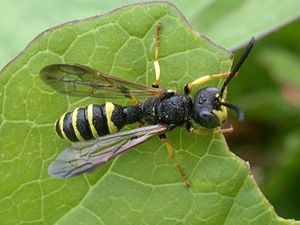Sandknot wasp
| Sandknot wasp | ||||||||||||
|---|---|---|---|---|---|---|---|---|---|---|---|---|

Sandknot Wasp ( Cerceris arenaria ) |
||||||||||||
| Systematics | ||||||||||||
|
||||||||||||
| Scientific name | ||||||||||||
| Cerceris arenaria | ||||||||||||
| ( Linnaeus , 1758) |
The sandknot wasp ( Cerceris arenaria ) is a hymenoptera from the Crabronidae family . The species is not endangered.
features
The animals reach a body length of 11 to 15 millimeters (females) or 8 to 12 millimeters (males). The head and thorax are black and have yellow markings. The black abdomen has a wide yellow band on each segment, which is missing on the last segment. The legs are almost completely yellow and have a red-brown markings. The projection of the frontal plate ( clypeus ) of the females is broad. The last antennae of the males is strongly curved. The species can be distinguished from the other nodular wasps by their size and the drawing of the abdomen.
Occurrence
The species occurs in northeast Africa and Europe. It is the most common nodal wasp in Central Europe and is widespread and common. It lives in open, sandy habitats, often near pine trees . The animals fly in one generation from late May to late September, with the peak in July.
Way of life
The animals usually nest in larger groups on open and sunlit sandy areas. The nest is created at the end of a vertical passage about 20 centimeters deep. The wasp pushes the sand upwards with the particularly flat abdominal end ("pygidial plate" of the telson ), creating a heap around the nest entrance. The entrance is widened to a narrow funnel. When the nest is ready, weevils are brought in as food for the larvae in flight . A foreleg is grasped with the mandibles and the body is clasped with the legs. It is mainly common gray weevils ( Brachyderes incanus ) that live on pines that are caught. In order to stun the beetles, the wasp has to sting between the joint membranes at the base of the legs with its stinger, as the rest of the body is too heavily armored. The nest is flown directly into the nest without prior dropping off. A total of up to 12 beetles are brought into a nest. The sand wasp is parasitized by the sand wasp ( Hedychrum nobile ) .
supporting documents
literature
- Heiko Bellmann : bees, wasps, ants. Hymenoptera of Central Europe . Franckh-Kosmos Verlags-GmbH & Co KG, Stuttgart 1995, ISBN 3-440-09690-4 .
- Rolf Witt: Wasps. Observe, determine. Naturbuch-Verlag, Augsburg 1998, ISBN 3-89440-243-1 .
Individual evidence
- ↑ a b c d Heiko Bellmann : Bees, wasps, ants. Hymenoptera of Central Europe . Franckh-Kosmos Verlags-GmbH & Co KG, Stuttgart 1995, p. 182 ff., ISBN 3-440-09690-4 .
- ↑ a b c d Rolf Witt: Wasps. Observe, determine. Naturbuch-Verlag, Augsburg 1998, ISBN 3-89440-243-1 .